构建第二个大脑:权威的入门指南 --- Building a Second Brain: The Definitive Introductory Guide
date_saved: 2024-03-21 17:21:52
date_published: 2023-05-01 09:00:12
Full Content:
This is an introduction to Building a Second Brain, the proven method to organize your digital life and unlock your creative potential. 这是对“构建第二大脑”的介绍,这是组织数字生活和释放创造潜力的行之有效的方法。
How many brilliant ideas have you had and forgotten? How many insights have you failed to take action on? How much useful advice have you slowly forgotten as the years have passed?
你曾经有过多少绝妙的想法却又被遗忘了?有多少见解您未能采取行动?随着岁月的流逝,您慢慢忘记了多少有用的建议?
We feel a constant pressure to be learning, improving ourselves, and making progress. We spend countless hours every year reading, listening, and watching informational content. And yet, where has all that valuable knowledge gone? Where is it when we need it?
我们感受到不断学习、提高自我和取得进步的压力。我们每年花费无数的时间阅读、聆听和观看信息内容。然而,所有这些宝贵的知识都到哪里去了?当我们需要的时候它在哪里?
Our brains just aren’t capable of remembering all these details since they can only store a few thoughts at any one time. Fundamentally, our brains are for having ideas, not storing them.
我们的大脑无法记住所有这些细节,因为它们在任何时候只能存储一些想法。从根本上说,我们的大脑是用来产生想法的,而不是储存它们的。
Building a Second Brain is a methodology for saving and systematically reminding us of the ideas, inspirations, insights, and connections we’ve gained through our experience. It provides a clear, actionable path to creating a “Second Brain” – an external, centralized, digital repository for the things you learn and the resources from which they come. A Second Brain ultimately expands our memory and our intellect using modern tools of technology.
构建第二个大脑是一种保存并系统地提醒我们通过经验获得的想法、灵感、见解和联系的方法。它提供了一条清晰、可操作的路径来创建“第二大脑”——一个外部的、集中的数字存储库,用于存储您所学到的东西及其来源的资源。第二大脑最终会利用现代技术工具来扩展我们的记忆力和智力。
Being effective in the world today requires managing many different kinds of information – emails, text messages, messaging apps, online articles, books, podcasts, webinars, meeting notes, and many others.
在当今世界上保持高效需要管理许多不同类型的信息——电子邮件、短信、消息应用程序、在线文章、书籍、播客、网络研讨会、会议记录等等。
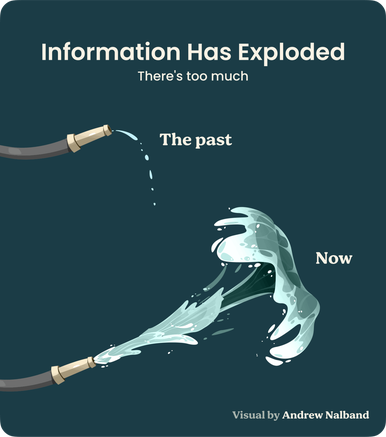
All of these kinds of content have value, but trying to remember all of it is overwhelming and impractical. By consolidating ideas from these sources, you’ll develop a valuable body of work to advance your projects and goals. You’ll have an ongoing record of personal discoveries, lessons learned, and actionable insights for any situation.
所有这些类型的内容都有价值,但试图记住所有这些内容是压倒性的且不切实际的。通过整合这些来源的想法,您将开发出有价值的工作来推进您的项目和目标。您将持续记录个人发现、经验教训以及针对任何情况的可行见解。
We are already doing most of the work required to consume this content. We spend a significant portion of our careers creating snippets of text, outlines, photos, videos, sketches, diagrams, webpages, notes, or documents. Yet, without a little extra care to preserve these valuable resources, our precious knowledge remains siloed and scattered across dozens of different locations. We fail to build a collection of knowledge that both appreciates in value and can be reused again and again.
我们已经完成了使用此内容所需的大部分工作。我们职业生涯的很大一部分时间都花在创建文本、大纲、照片、视频、草图、图表、网页、笔记或文档的片段上。然而,如果不额外注意保护这些宝贵的资源,我们宝贵的知识仍然是孤立的,分散在数十个不同的地点。我们未能建立一个既有价值又可以一次又一次重用的知识集合。
By offloading our thinking onto a Second brain, we free our biological brain to imagine, create, and simply be present. We can move through life confident that we will remember everything that matters, instead of floundering through our days struggling to keep track of every detail.
通过将我们的思维转移到第二个大脑上,我们可以释放我们的生物大脑来想象、创造和简单地存在。我们可以自信地度过一生,相信我们会记住所有重要的事情,而不是在生活中挣扎着追踪每一个细节。
Your Second Brain will serve as an extension of your mind, not only protecting you from the ravages of forgetfulness but also amplifying your efforts as you take on creative challenges.
你的第二大脑将作为你思想的延伸,不仅保护你免受健忘的破坏,而且在你接受创造性挑战时增强你的努力。
The Building a Second Brain Methodology will teach you how to:
构建第二个大脑方法将教您如何:
- Reduce stress and “information overload” by curating and managing your personal information stream
通过策划和管理您的个人信息流来减轻压力和“信息过载” - Create a digital environment that promotes clarity and peace of mind
创建一个促进清晰度和内心平静的数字环境 - Unlock the full value of the wealth of learning resources all around you, such as online courses, webinars, books, articles, forums, and podcasts
充分发挥您周围丰富学习资源的价值,例如在线课程、网络研讨会、书籍、文章、论坛和播客 - Find anything you’ve learned, touched, or thought about in the past within seconds
在几秒钟内找到您过去学到、接触或想到的任何内容 - Spend less time looking for things and more time doing the best, most creative work you are capable of
花更少的时间寻找东西,花更多的时间做你力所能及的最好、最具创造性的工作 - Cultivate a collection of valuable knowledge and insights over time without having to follow rigid, time-consuming rules
随着时间的推移,积累有价值的知识和见解,而不必遵循严格、耗时的规则 - Consistently move your projects and goals to completion by organizing and accessing your knowledge in a results-oriented way
通过以结果为导向的方式组织和获取您的知识,持续推动您的项目和目标的完成 - Turn work “off” and relax, knowing you have a trusted system keeping track of all the details
“关闭”工作并放松,知道您有一个可信赖的系统来跟踪所有细节
So, how do you build your Second Brain? 那么,如何打造你的第二大脑呢?
To guide you in the process of creating your own Second Brain, I’ve developed a simple four-step method called CODE, which stands for Capture, Organize, Distill, and Express.
为了指导您创建自己的第二大脑,我开发了一种简单的四步方法,称为“代码”,它代表“捕获”、“组织”、“蒸馏”和“表达”。
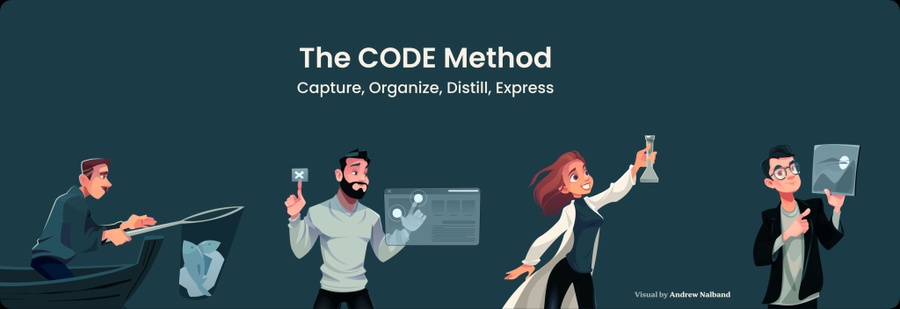
These are the steps not only to build your Second Brain but also to work with it going forward.
这些步骤不仅是构建你的第二大脑,也是未来与之合作的步骤。
CODE is a proven process for consistently turning the information you consume into creative output and concrete results. And it’s based on timeless principles that humans throughout history have used to create anything imaginable.
CODE 是一个经过验证的流程,可以持续将您消耗的信息转化为创意输出和具体结果。它基于人类历史上用来创造任何可以想象的任何事物的永恒原则。
The four steps of CODE are flexible and agnostic for any profession, role, or career and for whatever notetaking methods and platforms you prefer. You’re probably already doing them already in some form, whether you realize it or not.
CODE 的四个步骤对于任何职业、角色或职业以及您喜欢的任何笔记方法和平台都是灵活且不可知的。无论你是否意识到,你可能已经以某种形式做了这些事情。
Let me introduce you to each step, starting with Capture.
让我向您介绍每个步骤,从 Capture 开始。
Capture only the most important information
只捕获最重要的信息
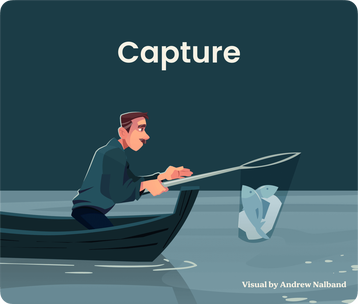
The first step in building a Second Brain is “capturing” the ideas and insights you think are worth saving. Ask yourself:
构建第二大脑的第一步是“捕捉”你认为值得保存的想法和见解。问你自己:
- What are the recurring themes and questions that I always seem to return to in my work and life?
我在工作和生活中似乎总是会回到的反复出现的主题和问题是什么? - What insightful, high-value, impactful information do I already have access to that could be valuable?
我已经可以获得哪些有洞察力、高价值、有影响力且可能有价值的信息? - Which knowledge do I want to interconnect, mix and match, and periodically resurface to stimulate future thinking on these subjects?
我想要互连、混合和匹配哪些知识,并定期重新出现以激发未来对这些主题的思考?
Most of the time we tend to capture information haphazardly – we email ourselves a quick note, brainstorm some ideas in a Word document, or take notes on books we read – but then don’t do anything with it.
大多数时候,我们倾向于随意地获取信息——我们通过电子邮件给自己发送一个简短的笔记,在Word文档中集思广益一些想法,或者在我们阅读的书籍上做笔记——但随后却没有用它做任何事情。
We are already consuming or producing this information, we just need to keep it in a single, centralized place, such as a digital notetaking app like Evernote, Microsoft OneNote, Notion, Apple Notes, Obsidian or others. These apps facilitate capturing small “snippets” of text as well as hyperlinks, images, webpages, screenshots, PDFs, and other attachments, all of which are saved permanently and synced across all your devices.
我们已经在消费或产生这些信息,我们只需将其保存在一个集中的地方,例如 Evernote、Microsoft OneNote、Notion、Apple Notes、Obsidian 等数字笔记应用程序。这些应用程序有助于捕获文本的小“片段”以及超链接、图像、网页、屏幕截图、PDF 和其他附件,所有这些都将永久保存并在您的所有设备上同步。
By keeping a diverse collection of information in one centralized place, it is now free to intermix and intermingle, helping us see unexpected connections and patterns in our thinking. This also gives us one place to look when we need creative raw material, supporting research, or a shot of inspiration.
通过将多样化的信息集中在一个集中的地方,它现在可以自由地混合和混合,帮助我们看到思维中意想不到的联系和模式。当我们需要创意原材料、支持研究或灵感时,这也为我们提供了一个可以寻找的地方。
The following three guidelines will help you capture only the most relevant and useful information in your Second Brain.
以下三个指南将帮助您仅捕获第二大脑中最相关和最有用的信息。
Think like a curator 像策展人一样思考
The second we pick up our mobile device or sit down in front of our computer, we become immersed in the flow of juicy information we are presented with.
当我们拿起移动设备或坐在电脑前时,我们就会沉浸在所呈现的丰富信息流中。
Much of this information is useful and interesting – articles written by experts that could make us more productive, tips on exercise and nutrition, or fascinating stories from around the world. But unless we make conscious, strategic decisions about what we consume, we’ll always be at the mercy of what others want us to see.
其中大部分信息都是有用且有趣的——专家撰写的文章可以提高我们的工作效率、锻炼和营养的建议,或者来自世界各地的精彩故事。但除非我们对我们的消费做出有意识的、战略性的决定,否则我们将永远受到别人希望我们看到的东西的摆布。
Too often, we just passively react to the information that’s been shoved in front of us by other people and algorithms.
很多时候,我们只是被动地对其他人和算法推到我们面前的信息做出反应。
How do you escape this reactivity loop? 如何摆脱这个反应循环?
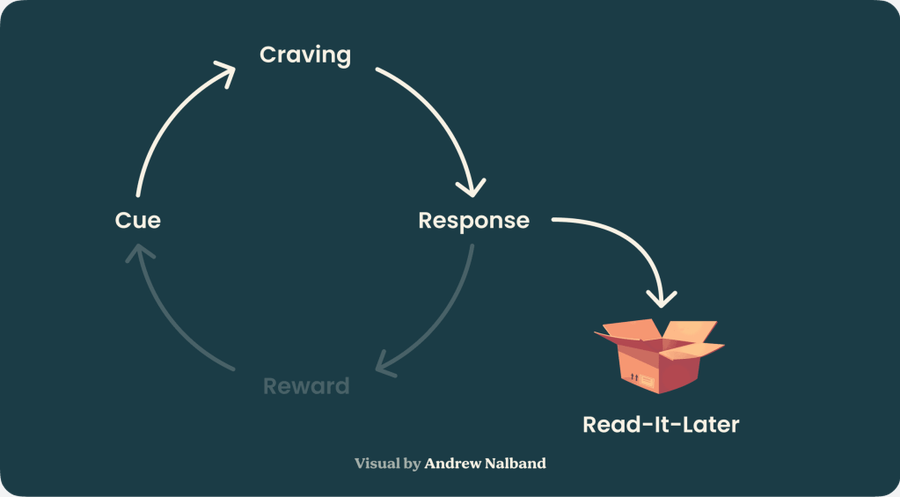
Instead of immediately consuming what’s in front of you, save it so you can revisit it later (at a time that’s reserved for consumption).
不要立即使用您面前的内容,而是将其保存起来,以便稍后(在预留的使用时间)重新访问它。
Read-later apps such as Readwise’s Reader, Instapaper, or Pocket are designed for this particular purpose. As you begin to collect content, you’ll be able to choose which sources to consume in a deliberate way.
Readwise 的 Reader、Instapaper 或 Pocket 等稍后阅读应用程序就是为此特定目的而设计的。当您开始收集内容时,您将能够以深思熟虑的方式选择要使用的来源。
Keep only what resonates 只保留能引起共鸣的内容
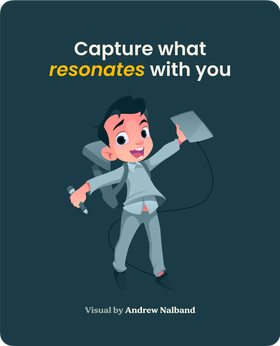
The word “capturing” often brings to mind an analytical way of thinking. But analysis is time-consuming and tiring. In deciding which passages, images, theories, or quotes to keep, don’t make it a highly intellectual, analytical decision.
“捕捉”这个词常常让人想起一种分析性的思维方式。但分析起来既费时又累。在决定保留哪些段落、图像、理论或引言时,不要让它成为一个高度理智、分析性的决定。
Instead, your rule of thumb should be to save anything that “resonates” with you on an intuitive level.
相反,你的经验法则应该是保存任何在直觉层面上与你“产生共鸣”的东西。
This is often because it connects to something you care about, wonder about, or find inherently intriguing. By training ourselves to notice when something resonates with us at a deeper level, we improve not only our ability to see opportunities, but also our understanding of ourselves and how we work.
这通常是因为它与你关心、好奇或觉得本质上有趣的事情有关。通过训练自己注意某些事物何时与我们产生更深层次的共鸣,我们不仅可以提高发现机会的能力,还可以提高对自己和工作方式的理解。
Utilize capture tools 利用捕捉工具
When you dive into the world of digital notetaking, you’ll soon come across an array of specialized “capture tools,” designed to make capturing content in digital form easy and even fun.
当您深入数字笔记世界时,您很快就会遇到一系列专门的“捕获工具”,这些工具旨在使捕获数字形式的内容变得简单甚至有趣。
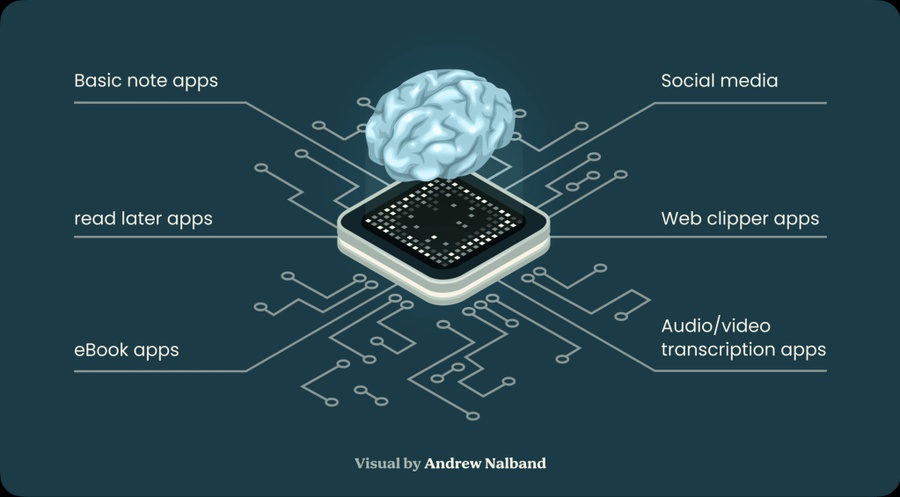
The most common options include:
最常见的选项包括:
- Ebook apps: Export your highlights or annotations from the books you’ve read
电子书应用程序:从您读过的书中导出您的亮点或注释 - Read later apps: Save content you find online for later consumption and export your highlights into your notetaking app
稍后阅读应用程序:保存您在网上找到的内容以供以后使用,并将您的亮点导出到您的笔记应用程序中 - Basic notes apps: Capture snippets of text on the fly with these preinstalled apps on your mobile device
基本笔记应用程序:使用移动设备上这些预装的应用程序即时捕获文本片段 - Social media apps: “Favorite” content and export it to your notetaking app
社交媒体应用程序:“收藏”内容并将其导出到您的笔记应用程序 - Audio/voice transcription apps: Create text transcripts from spoken words
音频/语音转录应用程序:从口语创建文本转录 - Web clipper apps: Save parts of web pages (often included as a built-in feature of notetaking apps)
网页剪辑应用程序:保存网页的一部分(通常作为笔记应用程序的内置功能包含在内)
While some of these tools are free, others charge a small fee. Some work silently in the background (for example, automatically syncing your ebook highlights with your notes app), and others require some manual effort (such as taking photos of paper notebooks to save them digitally).
虽然其中一些工具是免费的,但其他工具则收取少量费用。有些在后台默默工作(例如,自动将电子书亮点与笔记应用程序同步),而另一些则需要一些手动操作(例如拍摄纸质笔记本的照片以数字方式保存它们)。
In any case, the act of capturing takes seconds—to hit share, export, or save—and voilà, you’ve preserved the best parts of whatever you’re consuming in your Second Brain.
无论如何,捕捉的过程只需几秒钟——点击分享、导出或保存——瞧,你已经在你的第二大脑中保留了你正在消耗的任何东西的最好部分。
Since the software landscape is constantly changing, we’ve created a Resource Guide with updated recommendations of the best capture tools, both free and paid, and for a variety of devices and operating systems.
由于软件格局不断变化,我们创建了一份资源指南,其中包含针对各种设备和操作系统的最佳捕获工具(免费和付费)的最新建议。
Organize for actionability
组织可操作性
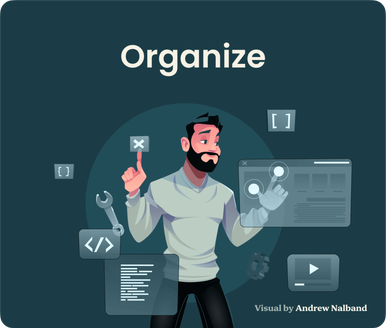
As you begin to collect notes on ideas that resonate with you, you will eventually feel the need to organize them.
当你开始收集与你产生共鸣的想法的笔记时,你最终会觉得有必要将它们组织起来。
It can be tempting to try to create a perfect hierarchy of folders from the get-go, with the aim of capturing every possible note you might ever come across. However, this approach is not only time-consuming, but it also diverts your attention from what interests you now, requiring too much effort.
从一开始就尝试创建完美的文件夹层次结构可能很诱人,目的是捕获您可能遇到的每一个可能的笔记。然而,这种做法不仅耗时,而且还会将你的注意力从你现在感兴趣的事情上转移,需要付出太多的努力。
Most people tend to organize information by subject, similar to the Dewey decimal system used in libraries. For example, books might be classified under broad subject categories such as “Architecture,” “Business,” “History,” or “Geology.”
大多数人倾向于按主题组织信息,类似于图书馆使用的杜威十进制系统。例如,书籍可以分为广泛的主题类别,例如“建筑”、“商业”、“历史”或“地质学”。
When it comes to digital notes, simpler and more flexible organization methods are preferable. Our priorities and goals can change quickly, so we should avoid organizing methods that are overly rigid and prescriptive.
当谈到数字笔记时,更倾向于更简单、更灵活的组织方法。我们的优先事项和目标可能会很快发生变化,因此我们应该避免过于僵化和规定性的组织方法。
The best way to organize your notes is to focus on your active projects. When you encounter new information, think about how it can help you move forward something you’re currently working on.
组织笔记的最佳方法是专注于您正在进行的项目。当您遇到新信息时,请考虑它如何帮助您推进当前正在处理的事情。
Surprisingly, focussing on taking action, will also help you combat information overwhelm. There are relatively few things that are actionable and relevant at any given time, which makes it easier to ignore everything else.
令人惊讶的是,专注于采取行动也将帮助你对抗信息淹没。在任何特定时间,可操作且相关的事情相对较少,这使得人们更容易忽略其他所有事情。
Organizing for action can provide a great sense of clarity because you know that everything you’re keeping has a purpose and aligns with your goals and priorities. Instead of being a hindrance to your productivity, organizing becomes a tool to enhance it.
组织行动可以提供一种极大的清晰度,因为你知道你所保留的一切都有目的,并且与你的目标和优先事项保持一致。组织不会成为你生产力的障碍,而是成为提高生产力的工具。
The following three guidelines will help you organize the information in your Second Brain effectively.
以下三个指南将帮助您有效地组织第二大脑中的信息。
Adopt the PARA Method 采用 PARA 方法
After more than a decade of personal experimentation, teaching thousands of students, and coaching world-class professionals, I’ve developed a way to organize information by actionability.
经过十多年的个人实验、教授数千名学生并指导世界一流的专业人士,我开发了一种通过可操作性来组织信息的方法。
It’s called PARA – a simple, comprehensive, yet extremely flexible system for organizing any type of digital information across any platform.
它被称为 PARA——一个简单、全面但极其灵活的系统,用于跨任何平台组织任何类型的数字信息。
Rest assured, adopting this approach will not only bring a sense of order to your life but also equip you with valuable tools to manage the flow of information and accomplish any goal you set for yourself.
请放心,采用这种方法不仅会给您的生活带来秩序感,还会为您提供宝贵的工具来管理信息流并实现您为自己设定的任何目标。
The PARA Method is grounded in a fundamental observation: that all the information in your life can be categorized into only four categories.
PARA 方法基于一个基本观察:生活中的所有信息只能分为四类。
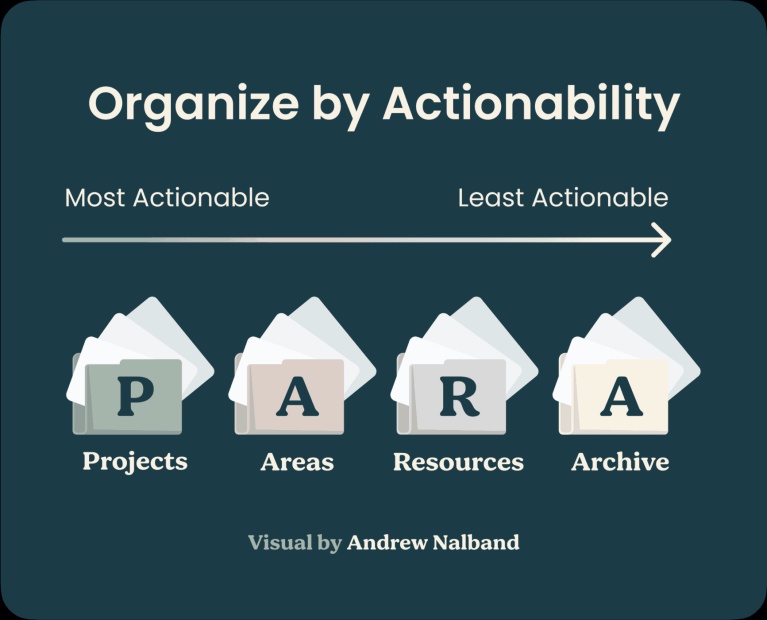
- Projects: short-term efforts (in your work or personal life) that you take on with a certain goal in mind
项目:为了实现某个目标而进行的短期努力(在工作或个人生活中) - Areas: Long-term responsibilities you want to manage over time
领域:您想要长期管理的职责 - Resources: Topics or interests that may be useful in the future
资源:将来可能有用的主题或兴趣 - Archive: Inactive items from the other 3 categories
存档:其他 3 个类别的非活动项目
It might be hard to accept that a sophisticated and contemporary human existence like yours can be reduced to just four categories. It may seem like you have more to manage than could possibly fit into such a basic system.
像你们这样复杂而当代的人类存在可以被简化为四种类别,这可能很难接受。看起来您需要管理的内容可能超出了这样一个基本系统的范围。
However, that is precisely the objective. If your organizational system is as intricate as your life, then the effort required to maintain it will deprive you of the time and energy necessary to actually live your life.
然而,这正是目标。如果你的组织系统和你的生活一样复杂,那么维护它所需的努力就会剥夺你实际生活所需的时间和精力。
The system you use to manage information must be so effortless that it liberates your focus rather than constraining it. Your system must provide you with time, not consume it.
您用来管理信息的系统必须轻松自如,能够解放您的注意力,而不是限制您的注意力。你的系统必须为你提供时间,而不是消耗它。
Start with a clean slate
从头开始
I found that the number one roadblock to implementing PARA or any other organizational system is that most people think they have to sort ALL their existing notes and files into it.
我发现实施 PARA 或任何其他组织系统的第一个障碍是大多数人认为他们必须将所有现有的笔记和文件分类到其中。
I couldn’t think of a more boring, demotivating task. It would take you hours if not days!
我想不出比这更无聊、更令人沮丧的任务了。如果不是几天的话,也需要几个小时!
And the result? You’ll probably feel just as overwhelmed by the sheer volume of information you now have to manage as before.
结果呢?您可能会像以前一样对现在必须管理的海量信息感到不知所措。
Here’s what I recommend instead (it will take you less than 60 seconds to do):
以下是我的建议(您只需不到 60 秒即可完成):
Move all existing files to a folder titled Archive with today’s date. 将所有现有文件移至标题为“存档”并包含当天日期的文件夹中。
Consider this folder a “time capsule” that preserves everything you had going on until this precise moment. Now, it separates what was saved prior to today’s date from what you’ll save from this point on.
将此文件夹视为一个“时间胶囊”,它保存了您在此时刻之前发生的所有事情。现在,它将今天之前保存的内容与从此时起保存的内容分开。
That’s it! Your digital workspace is now completely clean so you can start over.
就是这样!您的数字工作空间现已完全干净,因此您可以重新开始。
The best thing is that you’re not deleting anything. Whenever you need a file, you can always pull it out of your Archive folder. But my guess is that you won’t need as many old notes as you think you do.
最好的事情是你没有删除任何东西。每当您需要文件时,您随时可以将其从存档文件夹中取出。但我的猜测是,你不需要像你想象的那样多的旧笔记。
Ask three questions 问三个问题
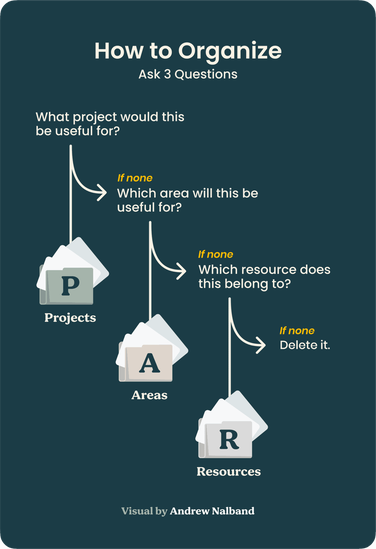
Now that you’re starting from a clean slate, how do you “process” any new items into the appropriate PARA folders?
既然您从头开始,如何将任何新项目“处理”到适当的 PARA 文件夹中?
Ask yourself the following three questions to consider in which project, area, or resource a given piece of information will be most relevant and useful.
问自己以下三个问题,考虑给定的信息在哪个项目、领域或资源中最相关和最有用。
- What project would this be useful?
这对什么项目有用? - If none: Which area will this be useful for?
如果没有:这对哪个领域有用? - If none: Which resource does this belong to?
如果没有:这属于哪个资源? - If none, it’s probably best to archive this information or not save it at all.
如果没有,最好存档此信息或根本不保存。
With some practice, this decision will only take you a few seconds.
通过一些练习,这个决定只需要你几秒钟的时间。
I prefer to do this “filing” in one batch about once a week. I pull up my “Inbox” – a separate folder as a temporary holding area where new items accumulate until I have time to put them in their proper place – and process 10-20 items in just a few minutes.
我更喜欢每周一次批量进行“归档”。我打开我的“收件箱”——一个单独的文件夹,作为临时存放区域,新邮件会在那里积累,直到我有时间将它们放在适当的位置——并在短短几分钟内处理 10-20 个邮件。
Don’t overthink where you’re going to put a certain piece of information within PARA. Remember that you can almost certainly find anything again using a simple search.
不要过度思考要将某条信息放在 PARA 中的什么位置。请记住,您几乎肯定可以通过简单的搜索再次找到任何内容。
Get the Second Brain Quickstart Guide
获取第二大脑快速入门指南
Our free 6-day email course will introduce you to the fundamentals of Building a Second Brain.
我们为期 6 天的免费电子邮件课程将向您介绍构建第二大脑的基础知识。
Distill down to the essence
提炼出本质
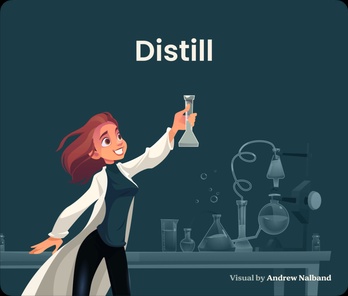
Once you start collecting valuable knowledge in a centralized place, you’ll naturally start to notice patterns and connections. An article you read on gardening will give you an insight into online marketing. An offhand comment by a client will give you the idea of creating a webpage with client testimonials. A business card you saved from a conference will remind you to follow up and propose a collaboration.
一旦你开始在一个集中的地方收集有价值的知识,你自然会开始注意到模式和联系。您阅读的有关园艺的文章将使您深入了解在线营销。客户的随意评论会给您创建一个包含客户推荐的网页的想法。您从会议中保存的名片将提醒您跟进并提出合作。
You can greatly facilitate and speed up this process by distilling your notes into actionable, bite-sized summaries.
通过将笔记提炼成可操作的简短摘要,可以极大地促进和加快这一过程。
It would be near impossible to review your 10 pages of notes on a book you read last year in the midst of a chaotic workday, for example. But if you had just the main points of that book in a 3-point summary, you could quickly remind yourself of what it contains and potentially apply it to something you’re working on.
例如,在混乱的工作日中复习去年读过的一本书的 10 页笔记几乎是不可能的。但如果你只用三点总结来概括这本书的要点,你就可以很快提醒自己它包含的内容,并有可能将其应用到你正在做的事情中。
The following three guidelines will help you summarize and distill your notes into actionable, useful tools for execution.
以下三个指南将帮助您总结笔记并将其提炼成可操作、有用的执行工具。
Design notes for your future self
为未来的自己设计笔记
A powerful mindset for interacting with our notes is to “design notes with your future self in mind.”
与笔记互动的一个强大的心态是“设计笔记时考虑到未来的自己”。
Think of notetaking as time travel. You’re sending packets of knowledge through time to your future self.
将记笔记视为时间旅行。你正在通过时间向未来的自己发送知识包。
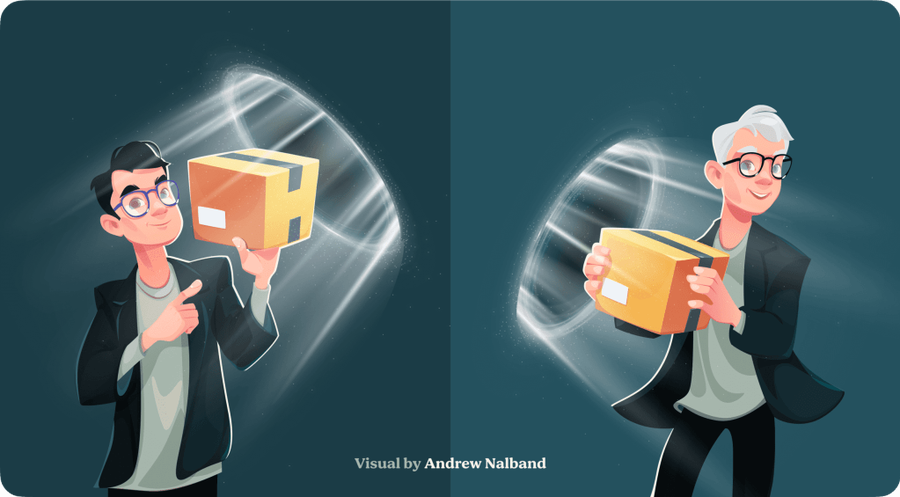
So the challenge is: “How do I make what I’m consuming right now easily discoverable for my future self?”
所以挑战是:“如何让未来的自己能够轻松发现我现在正在消费的东西?”
Every time you create a note or make an edit, you can make it just a little easier to find and make use of next time.
每次创建笔记或进行编辑时,都可以使其下次更容易查找和使用。
This can include: 这可以包括:
- Defining key terms in case we forget what they mean
定义关键术语,以防我们忘记它们的含义 - Inserting placeholders when we leave off so we know where to pick back up
当我们停止时插入占位符,以便我们知道从哪里继续 - Adding links to related websites, files, or emails that we’re likely to forget over time
添加我们可能会随着时间的推移而忘记的相关网站、文件或电子邮件的链接
By constantly saving packets of knowledge in a format that our future self can easily consume, we follow a “pay it forward” strategy that we get to benefit from in the future!
通过不断地以我们未来的自己可以轻松使用的格式保存知识包,我们遵循“向前支付”策略,我们将来可以从中受益!
Summarize progressively, at different levels of detail
在不同的细节层次上逐步总结
A common problem with notes is that they are too long and dense. You can’t afford the time it would take to review and remind yourself of everything they contain. Executive summaries can help, but often it is a challenge to identify what exactly the main point is in the first place.
笔记的一个常见问题是它们太长太密。你没有时间去回顾和提醒自己它们所包含的一切。执行摘要可以提供帮助,但通常要首先确定要点到底是什么是一个挑战。
Progressive Summarization is a technique that relies on summarizing a note in multiple stages over time.
渐进式总结是一种依赖于随着时间的推移分多个阶段总结笔记的技术。
You save only the best excerpts from whatever you’re reading, and then create a summary of those excerpts, and then a summary of that summary, distilling the essence of the content at each stage. These “layers” are like a digital map that can be zoomed in or out to any level of detail you need.
您只保存正在阅读的内容中的最佳摘录,然后创建这些摘录的摘要,然后创建该摘要的摘要,在每个阶段提炼内容的精髓。这些“图层”就像一张数字地图,可以放大或缩小到您需要的任何细节级别。
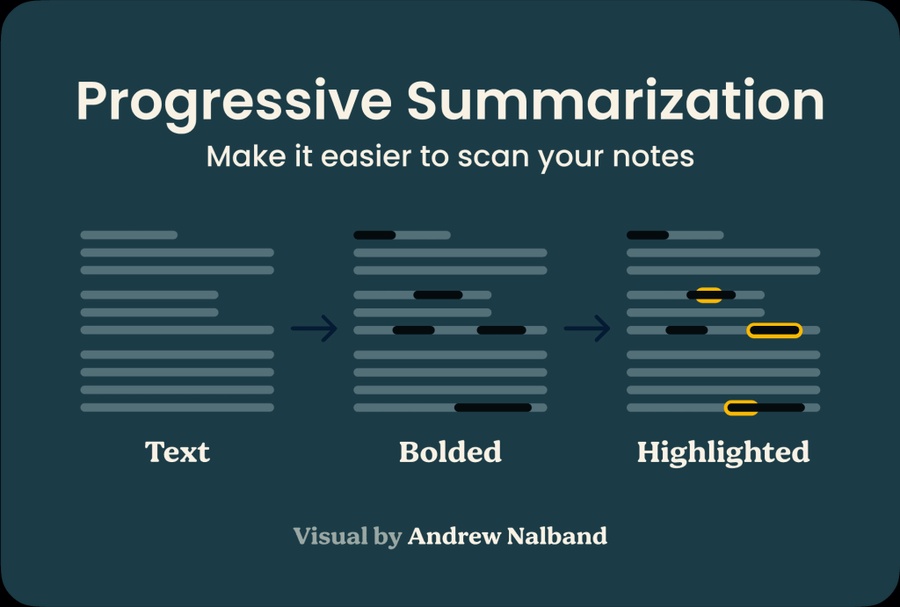
Progressive Summarization allows you to read the note in different ways for different purposes: in depth if you want to glean every detail, or at a high level if you just need the main takeaway. This allows you to review a note’s contents in seconds to decide if it’s useful for the task at hand.
渐进式总结允许您出于不同的目的以不同的方式阅读笔记:如果您想收集每个细节,则可以深入阅读;如果您只需要主要内容,则可以进行高层次的阅读。这使您可以在几秒钟内查看笔记的内容,以确定它是否对手头的任务有用。
Distill opportunistically, a little bit at a time
机会主义地蒸馏,一次一点点
It can be tempting to spend a lot of time creating highly structured, perfect notes. The problem is, you often have no idea which sources will end up being valuable until much later.
花大量时间创建高度结构化、完美的笔记可能很诱人。问题是,你常常不知道哪些来源最终会变得有价值,直到很久以后。
Instead of investing a lot of effort upfront, distill your notes opportunistically, in small bits over time
与其预先投入大量精力,不如随着时间的推移,机会主义地提炼你的笔记
Your rule of thumb should be: add value to a note every time you touch it. This could include adding an informative title the first time you come across a note, highlighting the most important points the next time you see it, and adding a link to a related note sometime later.
您的经验法则应该是:每次触摸笔记时都会为其添加价值。这可能包括在您第一次看到注释时添加信息丰富的标题,在您下次看到它时突出显示最重要的点,以及稍后添加指向相关注释的链接。
By spreading out the heavy work of distilling your notes over time, you not only save time and effort but ensure that the most frequently used (and thus most valuable) notes surface organically, like a ski slope where the most popular routes naturally end up with deeper grooves.
通过随着时间的推移分散提炼笔记的繁重工作,您不仅可以节省时间和精力,还可以确保最常用(因此也是最有价值)的笔记有机地浮现出来,就像滑雪场一样,最受欢迎的路线自然会出现在滑雪场上。更深的凹槽。
Express your unique ideas and experiences
表达您独特的想法和经历
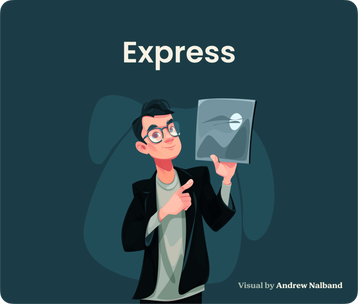
All of this capturing, organizing, and distilling has one ultimate purpose: creating tangible results in the real world. Whether we want to lose weight, get a promotion at work, start a side business, or contribute to a cause we believe in, the true purpose of learning is to turn our knowledge into effective action.
所有这些捕捉、组织和提炼都有一个最终目的:在现实世界中创造切实的结果。无论我们是想减肥、升职、开办副业还是为我们所信仰的事业做出贡献,学习的真正目的是将我们的知识转化为有效的行动。
With a substantial reserve of supporting material in your Second Brain, you never need to sit down to an empty page and try to “think of something smart.” All creativity stands on the shoulders of giants, and you have the benefit of already having the best ideas of those giants documented in your notes!
有了第二大脑中大量储备的支持材料,你永远不需要坐下来尝试“想出一些聪明的东西”。所有的创造力都站在巨人的肩膀上,而您的好处是已经将这些巨人的最佳想法记录在您的笔记中!
What should you create? 你应该创造什么?
It depends on your skills, interests, and personality. If you are analytical, you could draw on a group of articles you’ve read about Big Data to write a blog post summarizing where you think machine learning is headed next. If you like to perform, you could borrow ideas from your notes on YouTube cooking videos you’ve enjoyed to make one of your own. If you are campaigning for investment in your local park, you could distill the minutes from past city council meetings into a speaking agenda for your public comments at the next one.
这取决于您的技能、兴趣和个性。如果您善于分析,您可以利用您读过的一组有关大数据的文章来撰写博客文章,总结您认为机器学习的下一步发展方向。如果您喜欢表演,您可以借鉴您喜欢的 YouTube 烹饪视频笔记中的想法来制作自己的视频。如果您正在为当地公园的投资进行竞选活动,您可以将过去市议会会议的会议纪要提炼成演讲议程,以便在下一次会议上发表公众意见。
With a Second Brain at your disposal, you always have something to inspire you, remind you, support you, or guide you as you engage in the projects and interests that are important to you. You can draw on the sum total of your life experience and learning, not just whatever you can think of in the moment.
有了“第二大脑”,您在从事对您重要的项目和兴趣时,总能得到一些东西来激励您、提醒您、支持您或指导您。你可以利用你的生活经验和学习的总和,而不仅仅是你当下能想到的任何东西。
The following three guidelines will help you create more, better, and more meaningful creative output for whatever purpose you decide is important.
以下三个指南将帮助您为您认为重要的任何目的创造更多、更好、更有意义的创意输出。
Don’t just consume information passively – put it to use
不要只是被动地消费信息——要充分利用它
A common challenge for people who love to learn is that they constantly force-feed themselves more and more information, but never actually put it to use.
对于热爱学习的人来说,一个常见的挑战是他们不断地强迫自己输入越来越多的信息,但从未真正运用它们。
The goals and the experiences that would enrich their lives get endlessly postponed, waiting for the “right” bit of knowledge they supposedly need before getting started.
本来可以丰富他们生活的目标和经历被无限期地推迟,等待他们在开始之前需要的“正确”知识。
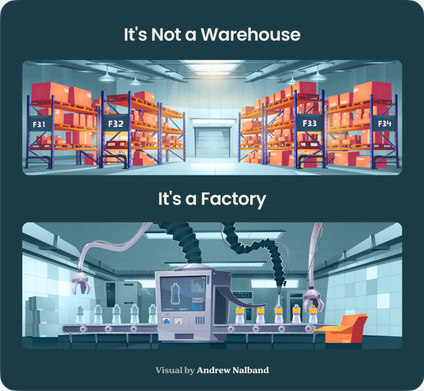
But information only becomes knowledge – something personal, embodied, grounded – when we put it to use. That’s why we should shift as much of our effort as possible from consuming information, to creating new things. The things we create – whether they are writing pieces, websites, photographs, videos, or live performances – embody and express the knowledge we’ve gained from personal experience.
但只有当我们使用信息时,信息才会变成知识——一些个人的、具体的、有根据的东西。这就是为什么我们应该将尽可能多的努力从消费信息转向创造新事物。我们创造的东西——无论是文字、网站、照片、视频还是现场表演——都体现并表达了我们从个人经验中获得的知识。
Think of your Second Brain not as a warehouse where you simply store your most valuable ideas, but as a factory that helps you turn those ideas into concrete results.
不要把你的第二大脑想象成一个简单地存储你最有价值的想法的仓库,而是一个帮助你将这些想法转化为具体结果的工厂。
We all need to be part of bringing to life something good, true, or beautiful. Creating things is not only deeply fulfilling, it can also bring us unexpected opportunities, introduce us to new friends or collaborators, and have a positive impact on others – by inspiring them, entertaining them, or informing them.
我们都需要成为将美好、真实或美丽的事物带入生活的一部分。创造事物不仅能给我们带来深刻的满足感,还能给我们带来意想不到的机会,把我们介绍给新朋友或合作者,并通过激励他们、娱乐他们或告知他们,对他人产生积极的影响。
Create smaller, reusable units of work
创建更小、可重复使用的工作单元
Once you start to curate a collection of valuable knowledge in external form, a very different way of working becomes not only possible, but necessary.
一旦你开始以外部形式收集有价值的知识,一种截然不同的工作方式不仅是可能的,而且是必要的。
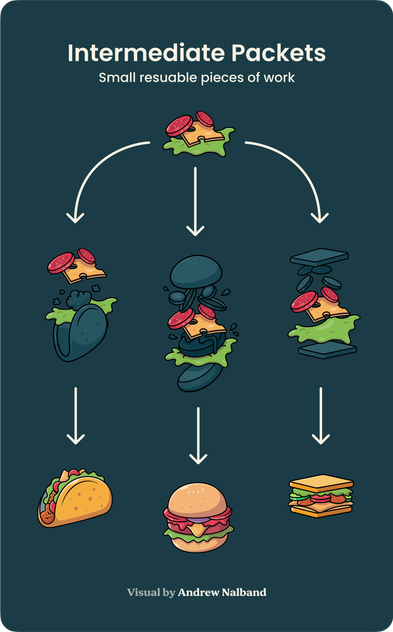
You will begin to think of your projects as made up of discrete parts.
您将开始认为您的项目是由离散的部分组成的。
I call them Intermediate Packets, which can include any kind of content we’ve already mentioned: a set of notes from a team meeting, a list of relevant research findings, a brainstorm with collaborators, a slide deck analyzing the market, or a list of action items from a conference call, for example.
我将它们称为“中间数据包”,其中可以包含我们已经提到的任何类型的内容:团队会议的一组笔记、相关研究结果列表、与合作者的头脑风暴、分析市场的幻灯片或列表例如,电话会议中的行动项目。
Instead of trying to sit down and move the entire project forward all at once, which is like trying to roll a giant boulder uphill, a more effective approach is to end each work session – whether it is 15 minutes or 3 hours – by completing just one Intermediate Packet.
与其尝试坐下来一次性推进整个项目(这就像试图将一块巨石推上山),更有效的方法是在每次工作结束时(无论是 15 分钟还是 3 小时)只需完成一个中间数据包。
This allows you to work in smaller increments, making use of any available span of time, while getting lots of feedback and taking frequent breaks.
这使您能够以较小的增量工作,利用任何可用的时间跨度,同时获得大量反馈并经常休息。
Not only does this result in higher quality output, it fuels the motivation and the inspiration that we need to do our best work. These Intermediate Packets can then be saved to your Second Brain, and re-used the next time you have a similar need.
这不仅可以带来更高质量的输出,还可以激发我们做好工作所需的动力和灵感。然后可以将这些中间数据包保存到您的第二大脑,并在下次有类似需求时重新使用。
Share your work with the world
与世界分享你的作品
There are many benefits all along the process of building a Second Brain: less stress, better focus, more insights, and enhanced productivity. But the real payoff comes at the end, when you create something out of the knowledge you’ve collected and share it with the world.
构建第二大脑的过程有很多好处:压力更小、注意力更集中、洞察力更强、生产力更高。但真正的回报是在最后,当你利用所收集的知识创造出一些东西并与世界分享时。
It can be tempting to wait until everything is “ready,” until you have all the information you think you need, and all the sources have been double-checked and reviewed. But as you continually curate and save pieces of content, review and summarize them, create a series of Intermediate Packets, and then recycle them back into your Second Brain, you’ll start to realize that there is no such thing as a finished product.
您可能会很想等到一切都“准备好”,直到您拥有您认为需要的所有信息,并且所有来源都经过仔细检查和审查。但当你不断地策划和保存内容片段、审查和总结它们、创建一系列中间数据包,然后将它们回收回你的第二大脑时,你会开始意识到不存在所谓的成品。
Everything is in flux, everything is a work in progress, and everything you put out there has an implicit “version 1.0” attached to it.
一切都在变化,一切都在进行中,你发布的一切都带有隐含的“1.0 版本”。
This can be tremendously empowering – since nothing is ever final, there is no need to wait to get started. You can publish a simple website now, and slowly add additional pages as you have time. You can publish a draft blog post now, and make revisions later after you’ve received feedback. You could even self-publish an ebook on the Kindle store, and any future updates to the manuscript will be wirelessly synced to everyone who purchased the book.
这可以带来巨大的力量——因为没有什么是最终的,所以没有必要等待开始。您现在可以发布一个简单的网站,并在有时间时慢慢添加其他页面。您现在可以发布博客文章草稿,并在收到反馈后进行修改。您甚至可以在 Kindle 商店上自行出版电子书,并且手稿的任何未来更新都将无线同步给购买该书的每个人。
By consistently sharing your work with others – whether that is your family, friends, colleagues, or externally on social media – all sorts of benefits will start to materialize.
通过不断地与他人分享你的工作——无论是你的家人、朋友、同事,还是在社交媒体上的外部——各种好处都将开始实现。
You’ll connect with new collaborators who you never would have imagined would find your work compelling. You’ll attract clients or customers, in some cases even when you weren’t seeking them. Others will reflect back to you their reactions and comments and appreciation (and occasionally criticism). You’ll find that you are part of a community that shares your interests and values.
您将与新合作者建立联系,您从未想象过他们会发现您的工作引人注目。您会吸引客户或消费者,在某些情况下,即使您并没有在寻找他们。其他人会向您反映他们的反应、评论和赞赏(偶尔还有批评)。您会发现您是一个分享您的兴趣和价值观的社区的一部分。
Accomplishing anything meaningful or important requires working with others, and the incredible power of the internet now allows us to find each other no matter how obscure or strange our interests.
完成任何有意义或重要的事情都需要与他人合作,而互联网令人难以置信的力量现在使我们能够找到彼此,无论我们的兴趣多么模糊或奇怪。
The power of having a Second Brain
拥有第二大脑的力量
Each note in your Second Brain is a record of something you’ve experienced in your life – whether that is from reading a book, having an interesting conversation, or completing a project at work.
第二大脑中的每个笔记都是您生活中经历过的事情的记录——无论是阅读一本书、进行有趣的对话还是完成工作项目。
With all your most valuable ideas at your fingertips at all times, you never need to struggle and strain to remember everything you’ve learned. 所有最有价值的想法始终触手可及,您无需费力去记住您所学到的一切。
As your Second Brain gains momentum over weeks and months, you will start to become different. You will no longer think about things in isolation, but as part of a network of ideas in which everything affects everything else. You’ll realize that something you learned at work about effective communication also applies to your family vacation debate. A random fact you read in an airplane magazine will somehow end up being useful in a blog post you’re writing. A lesson from Ancient Greek history you picked up from a podcast on your morning commute will help you deal with a crisis at the office.
当你的第二大脑在数周和数月内获得动力时,你将开始变得不同。你将不再孤立地思考事物,而是作为思想网络的一部分,在这个思想网络中,一切都会影响其他一切。您会意识到,您在工作中学到的有关有效沟通的知识也适用于您的家庭假期辩论。您在飞机杂志上读到的随机事实最终会在您正在撰写的博客文章中发挥作用。您在早上通勤时从播客中学到的古希腊历史课程将帮助您应对办公室危机。
You will start to think in terms of the systems and principles that you’ve gleaned through your summarizing and reviewing, and see them everywhere. Your mind will start to work differently, learning to depend on this external tool to draw on resources, references, and research far beyond what it can remember on its own. You will start to conceive of “your work” as an integrated whole that you can actually point to, shape, and navigate in a direction of your choosing. You’ll be more objective and unattached, because if any single idea doesn’t work out, you know you have a huge trove of others ready to go.
你将开始根据你通过总结和回顾收集到的系统和原则进行思考,并且到处都能看到它们。你的思维将开始以不同的方式工作,学会依赖这个外部工具来利用远远超出它自己记忆范围的资源、参考资料和研究。您将开始将“您的工作”视为一个完整的整体,您可以实际指向、塑造和导航到您选择的方向。你会变得更加客观和独立,因为如果任何一个想法不起作用,你知道你还有大量其他想法可以实施。
Over time, you will start to recognize that everything you are learning and experiencing makes sense. You can see, mapped in the notes you are cultivating, the underlying structure of your life. Why you do things, what you really want, what’s really important and what isn’t.
随着时间的推移,你会开始认识到你正在学习和经历的一切都是有意义的。你可以在你正在培养的笔记中看到你生活的基本结构。你为什么做事,你真正想要什么,什么是真正重要的,什么不是。
Your Second Brain becomes like a mirror, reflecting back to you who you think you are, who you want to be, and who you could become. Because you know how to capture and make use of anything, every experience you have becomes an opportunity to learn and grow.
你的第二大脑变得像一面镜子,反射出你认为自己是谁、你想成为谁以及你可以成为谁。因为你知道如何捕捉和利用任何东西,所以你的每一次经历都成为学习和成长的机会。
As this self-understanding dawns, you will look around at the notes you’ve collected, and you will realize that you already have everything you need to get started. You will start combining the ideas together, forming new perspectives, new theories, and new strategies. Ideas about society, about art, about psychology, about spirituality, about technology will start intermixing and spawning ideas you’ve never consciously considered. You’ll be shocked, in fact, at the elegance and power of what pops out of your notes.
当这种自我理解开始出现时,你会环顾四周你收集的笔记,你会意识到你已经拥有了开始所需的一切。你将开始将这些想法结合在一起,形成新的观点、新的理论和新的策略。关于社会、关于艺术、关于心理学、关于灵性、关于技术的想法将开始混合并产生你从未有意识地考虑过的想法。事实上,你会对笔记中的优雅和力量感到震惊。
This epiphany won’t just exist in your head. People can tell. They’ll start to notice that you can draw on an unusually large body of knowledge at a moment’s notice. They will admire your amazing memory, but what they don’t know is that you never try to remember anything. They’ll admire your incredible self-discipline and dedication at developing ideas over time, not knowing that you’ve created a system in which insights and connections emerge organically. They’ll be impressed by your ability to produce so much creative output, but in reality, you never lock yourself in a room to “crank out” some work. You just let your projects simmer until they’re ready.
这种顿悟不仅仅存在于你的脑海中。人们可以说出来。他们会开始注意到你可以立即利用异常庞大的知识体系。他们会钦佩你惊人的记忆力,但他们不知道的是你从来没有试图记住任何事情。随着时间的推移,他们会钦佩你令人难以置信的自律和在开发想法方面的奉献精神,而不知道你已经创建了一个可以有机地产生洞察力和联系的系统。他们会对你产生如此多创意成果的能力印象深刻,但实际上,你永远不会把自己锁在房间里“搞定”一些工作。你只需让你的项目慢慢酝酿,直到它们准备好。
Building a Second Brain is an integrated set of behaviors for turning incoming information into completed creative projects. 构建第二个大脑是一套集成的行为,用于将传入的信息转化为完成的创意项目。
Instead of endlessly optimizing yourself, trying to become a productivity machine that never deviates from the plan, it has you optimize an external system that is more reliable than you will ever be. This frees you to imagine, to wonder, to wander toward whatever makes you come alive here and now in the moment.
它不是无休止地优化自己,试图成为一台永远不会偏离计划的生产力机器,而是让你优化一个比你以往任何时候都更可靠的外部系统。这可以让你自由地想象、思考、漫步到任何让你此时此地充满活力的事物。
Your next steps 您的下一步
Here are three ways to start building your Second Brain:
以下是开始构建第二大脑的三种方法:
- Get the BASB Book: Learn the proven method to organize your digital life and unlock your creative potential.
获取 BASB 书籍:学习经过验证的方法来组织您的数字生活并释放您的创造潜力。 - Join BASB Foundation: Build your Second Brain on your own time and at your own pace with our self-paced course.
加入 BASB 基金会:通过我们的自定进度课程,按照您自己的时间和节奏打造您的第二大脑。 - Join the next BASB live cohort: Build your fully functional Second Brain with the momentum, accountability, and support of our team and like-minded Second Brainers.
加入下一个 BASB 现场队列:借助我们团队和志同道合的第二大脑的动力、责任和支持,打造功能齐全的第二大脑。
The beautiful visuals in this blog post were created by Andrew Nalband, founder of Thunk Notes. 这篇博文中的精美视觉效果是由 Thunk Notes 的创始人 Andrew Nalband 创建的。
Get the Second Brain Quickstart Guide
获取第二大脑快速入门指南
Our free 6-day email course will introduce you to the fundamentals of Building a Second Brain.
我们为期 6 天的免费电子邮件课程将向您介绍构建第二大脑的基础知识。
- POSTED IN: Building a Second Brain, Education, Note-taking, Organizing, Productivity, Workflow
发表于:建立第二个大脑、教育、记笔记、组织、生产力、工作流程
Highlights
构建第二个大脑:权威的入门指南 --- Building a Second Brain: The Definitive Introductory Guide ⤴️
Our brains just aren’t capable of remembering all these details since they can only store a few thoughts at any one time. Fundamentally, our brains are for having ideas, not storing them. ⤴️
a “Second Brain” – an external, centralized, digital repository for the things you learn ⤴️
an ongoing record of personal discoveries, lessons learned, and actionable insights for any situation. ⤴️
spend a significant portion of our careers creating snippets of text, outlines, photos, videos, sketches, diagrams, webpages, notes, or documents. Yet, without a little extra care to preserve these valuable resources, our precious knowledge remains siloed and scattered across dozens of different locations. ⤴️
free our biological brain to imagine, create, and simply be present. ⤴️
Create a digital environment ⤴️
Unlock the full value of the wealth of learning resources all around you, such as online courses, webinars, books, articles, forums, and podcasts ⤴️
Find anything you’ve learned, touched, or thought about in the past within seconds ⤴️
more time doing the best, most creative work you are capable of ⤴️
Cultivate a collection of valuable knowledge and insights ⤴️
CODE, which stands for Capture, Organize, Distill, and Express. ⤴️
is “capturing” the ideas and insights you think are worth saving ⤴️
Most of the time we tend to capture information haphazardly – we email ourselves a quick note, brainstorm some ideas in a Word document, or take notes on books we read – but then don’t do anything with it. ⤴️
we just need to keep it in a single, centralized place, such as a digital notetaking app ⤴️
all of which are saved permanently and synced across all your devices. ⤴️
one place to look when we need creative raw material, supporting research, or a shot of inspiration. ⤴️
unless we make conscious, strategic decisions about what we consume, we’ll always be at the mercy of what others want us to see. ⤴️
The word “capturing” often brings to mind an analytical way of thinking. But analysis is time-consuming and tiring. In deciding which passages, images, theories, or quotes to keep, don’t make it a highly intellectual, analytical decision. ⤴️
Too often, we just passively react to the information that’s been shoved in front of us by other people and algorithms. ⤴️
save it so you can revisit it later (at a time that’s reserved for consumption). ⤴️
something you care about, wonder about ⤴️
Read-later apps such as Readwise’s Reader, Instapaper, or Pocket are designed for this particular purpose. As you begin to collect content, you’ll be able to choose which sources to consume in a deliberate way. ⤴️
“capture tools,” designed to make capturing content in digital form easy and even fun. ⤴️
Ebook apps ⤴️
Read later apps: Save content you find online for later consumption and export your highlights into your notetaking app ⤴️
Basic notes apps: Capture snippets of text on the fly with these preinstalled apps on your mobile device ⤴️
Audio/voice transcription apps: Create text transcripts from spoken words ⤴️
Web clipper apps: Save parts of web pages (often included as a built-in feature of notetaking apps) ⤴️
In any case, the act of capturing takes seconds—to hit share, export, or save—and voilà, you’ve preserved the best parts of whatever you’re consuming in your Second Brain. ⤴️
Since the software landscape is constantly changing, we’ve created a Resource Guide with updated recommendations of the best capture tools, both free and paid, and for a variety of devices and operating systems. ⤴️
The best way to organize your notes is to focus on your active projects. ⤴️
focussing on taking action, will also help you combat information overwhelm. ⤴️
There are relatively few things that are actionable and relevant at any given time, which makes it easier to ignore everything else. ⤴️
Organizing for action can provide a great sense of clarity because you know that everything you’re keeping has a purpose and aligns with your goals and priorities. Instead of being a hindrance to your productivity, organizing becomes a tool to enhance it. ⤴️
all the information in your life can be categorized into only four categories.
- Projects: short-term efforts (in your work or personal life) that you take on with a certain goal in mind
- Areas: Long-term responsibilities you want to manage over time
- Resources: Topics or interests that may be useful in the future
- Archive: Inactive items from the other 3 categories ⤴️
I found that the number one roadblock to implementing PARA or any other organizational system is that most people think they have to sort ALL their existing notes and files into it. ⤴️
Here’s what I recommend instead (it will take you less than 60 seconds to do):
Move all existing files to a folder titled Archive with today’s date. ⤴️
The best thing is that you’re not deleting anything. Whenever you need a file, you can always pull it out of your Archive folder. But my guess is that you won’t need as many old notes as you think you do. ⤴️
Ask three questions
distilling your notes into actionable, bite-sized summaries. ⤴️
But if you had just the main points of that book in a 3-point summary, you could quickly remind yourself of what it contains and potentially apply it to something you’re working on. ⤴️
Design notes for your future self
A powerful mindset for interacting with our notes is to “design notes with your future self in mind.” ⤴️
You’re sending packets of knowledge through time to your future self.
make it just a little easier to find and make use of next time.
This can include:
- Defining key terms in case we forget what they mean
- Inserting placeholders when we leave off so we know where to pick back up
- Adding links to related websites, files, or emails that we’re likely to forget over time ⤴️
Summarize progressively, at different levels of detail ⤴️
A common problem with notes is that they are too long and dense. ⤴️
Executive summaries can help, but often it is a challenge to identify what exactly the main point is in the first place. ⤴️
Progressive Summarization is a technique that relies on summarizing a note in multiple stages over time. ⤴️
You save only the best excerpts from whatever you’re reading, and then create a summary of those excerpts, and then a summary of that summary, distilling the essence of the content at each stage. These “layers” are like a digital map that can be zoomed in or out to any level of detail you need.
Progressive Summarization allows you to read the note in different ways for different purposes: in depth if you want to glean every detail, or at a high level if you just need the main takeaway. This allows you to review a note’s contents in seconds to decide if it’s useful for the task at hand. ⤴️
you often have no idea which sources will end up being valuable until much later. ⤴️
add value to a note every time you touch it. ⤴️
All of this capturing, organizing, and distilling has one ultimate purpose: creating tangible results in the real world. ⤴️
the true purpose of learning is to turn our knowledge into effective action. ⤴️
You can draw on the sum total of your life experience and learning, not just whatever you can think of in the moment. ⤴️
Don’t just consume information passively – put it to use ⤴️
A common challenge for people who love to learn is that they constantly force-feed themselves more and more information, but never actually put it to use. ⤴️
shift as much of our effort as possible from consuming information, to creating new things. ⤴️
The things we create – whether they are writing pieces, websites, photographs, videos, or live performances – embody and express the knowledge we’ve gained from personal experience. ⤴️
Think of your Second Brain not as a warehouse where you simply store your most valuable ideas, but as a factory that helps you turn those ideas into concrete results. ⤴️
Create smaller, reusable units of work ⤴️
Intermediate Packets ⤴️
But the real payoff comes at the end, when you create something out of the knowledge you’ve collected and share it with the world. ⤴️
there is no such thing as a finished product. ⤴️
Everything is in flux, everything is a work in progress ⤴️
since nothing is ever final, there is no need to wait to get started ⤴️
You can publish a simple website now, and slowly add additional pages as you have time. ⤴️
By consistently sharing your work with others – whether that is your family, friends, colleagues, or externally on social media – all sorts of benefits will start to materialize. ⤴️
Others will reflect back to you their reactions and comments and appreciation (and occasionally criticism). You’ll find that you are part of a community that shares your interests and values. ⤴️
Accomplishing anything meaningful or important requires working with others ⤴️
With all your most valuable ideas at your fingertips at all times, you never need to struggle and strain to remember everything you’ve learned. ⤴️
You will start to think in terms of the systems and principles that you’ve gleaned through your summarizing and reviewing, and see them everywhere. ⤴️
As this self-understanding dawns, you will look around at the notes you’ve collected, and you will realize that you already have everything you need to get started. ⤴️
incredible self-discipline and dedication at developing ideas over time, not knowing that you’ve created a system in which insights and connections emerge organically. They’ll ⤴️
Building a Second Brain is an integrated set of behaviors for turning incoming information into completed creative projects. ⤴️